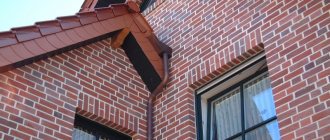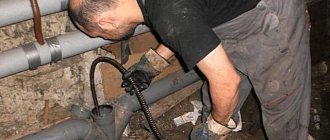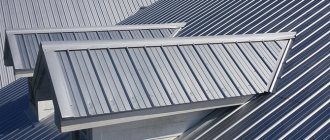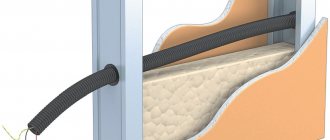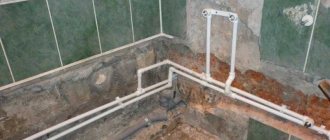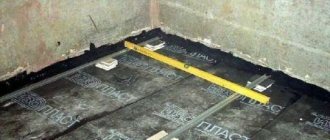In the construction of an external sewer system, the simplest (but no less important) work is laying sewer pipes.
For those who decide to install an external sewer system on their own, you definitely need to know the features of laying pipes in the ground, as well as the principle of selecting building materials, so our article will be very helpful.
If you are interested in the placement of the pipeline in the house, you should read the article “Laying sewer pipes”.
Selection of materials
Through the internal sewerage system, wastewater is removed from buildings and transported through an external pipeline to treatment facilities - central or local (septic tanks).
In order for your sewer system to cope with its tasks effectively, you must know how to lay sewer pipes on your site.
For the construction of an external sewer system, it is advisable to use smooth orange polymer pipes:
- polyethylene (PE);
- polypropylene (PP);
- polyvinyl chloride (PVC).
If the laying depth is significant or the sewer pipes are expected to be subject to dynamic loads (in cases where sewerage passes under pedestrian and highway roads), it is better to prefer corrugated double-layer pipes made of PE or PP.
The connection of polymer pipes occurs through shaped products - adapters, couplings, bends, etc.
Most often, external sewer pipelines are constructed from orange polymer pipes with a diameter of 110 mm.
Painting pipes orange indicates their purpose - for external sewerage; they are more durable and strong than gray products used in the construction of internal pipelines.
Pipes laid underground for external sewerage are less susceptible to corrosion, destruction and, when laid with the correct slope, do not create blockages due to the smooth structure of the inner wall. The maximum permissible depth of such pipes in the ground is 3 m.
Forming a slope for free flow
When laying the pipeline, it is necessary to provide a slope towards the septic tank. According to technological standards, the slope of a sewer pipe with a diameter of 110 mm should be 20 mm for each meter of pipeline. Pipes with a diameter of 160 mm must be laid with a slope of 8 mm per meter of laid line.
When laying pipes, the slope is calculated for one meter of pipeline. The figure shows how much the difference should be between the sides of pipes with different diameters
The presence of a slope is a determining parameter for the successful functioning of the system. The closer the pipeline performance is to the standard, the more efficient the sewage system will work.
A complete lack of slope, as well as excessive slope of the pipeline, will lead to siltation of the system. In the first case, waste will not be able to be transported through the pipes at the required speed, which will lead to the formation of blockages.
In the second, the liquid will move too quickly, which will ultimately reduce its transport capacity, and waste will remain in the pipe, which will also lead to blockages and further silting of the pipeline.
The slope of the pipeline should always be directed from the outlet of the residential building towards the septic tank. This condition is especially important when using non-pressure sewers, which are most often equipped in private households.
You can control the slope level of the entire trench using a special device - a level. If the device is not available on the farm, then the slope is checked using a building level.
Procedure:
- At the beginning and end of the pit, pins are driven in to which the cable is tied.
- A building level is applied to one end of the rope and adjustments are made to the horizon.
- The height of the trench is measured from both sides to the cable.
- Simple mathematical calculations are performed.
For example, the total length of the trench is 50 m, a pipe with a diameter of 110 mm is used. On the exit side of the house, the depth of the pit is half a meter. In this case, at the end point of the pit, its depth should be equal to one and a half meters.
Detailed technology for calculating sewer slope is described in this article.
If the site has a natural slope that exceeds the recommended standards, it is possible to lay a sewer system with several vertical transitions. In this case, on horizontal sections of the pipeline it is necessary to comply with regulatory indicators.
In areas with a large slope, the pipeline can be laid in a stepwise manner. If the slope angle slightly exceeds the standards, they are limited to one vertical transition (+)
Another option is to lay a vertical pipe at the exit from the house to a considerable depth, and then lay a pipeline from it with the required slope. In this case, the depth of the trench will be greater than when laying using the first method.
For the same purposes, you can use a drop well, into which wastewater flows smoothly to a lower level of the pipeline.
Pipe laying technology
Preparing the trench
Having decided on the material, familiarize yourself with how to properly lay sewer pipes. Installation of external sewerage begins with preparing a trench, which can be dug manually with a shovel or using an excavator.
The depth of the furrows depends on the depth of soil freezing in a particular area. According to SNiP P-G.3-62, the depth of laying sewer pipes is 0.5 m less than the soil freezing mark and is approximately:
- 3 ÷ 3.5 m – in the northern regions of the Russian Federation;
- 2.5 ÷ 3 – in the middle zone;
- 1.25 ÷ 2 – on the Black Sea coast.
The indicated figures are not categorical and may vary within certain limits depending on the terrain and groundwater level. However, laying sewer pipes in the ground must be done at least 0.5 m from the surface.
When using pipes of 110 mm diameter, depressions are dug in the soil 0.6 m wide and 0.05 m deep than the depth of the pipes.
The trench has its own characteristics:
- The bottom of the trench is leveled, the necessary slope is created, as a rule, 1-2 cm for each linear meter of the pipeline.
- After leveling the bottom, it is necessary to thoroughly compact the soil and arrange a cushion of gravel or sand 10-15 cm high.
- A sand or gravel bed must be compacted in an area located 2 m before the inspection well and at the junction of the pipeline with the inlet pipe.
- Where the sockets will be located in the sewer system, pits should be formed.
Pipeline installation
Next comes the actual installation of the pipeline. It is better to start laying from the foundation of the building.
The technology for laying sewer pipes looks like this:
- The pipes are laid with the socket down in prepared trenches.
- To connect two pipes to each other, the socket of one and the smooth end of the other are cleaned of dirt.
- The joints are lubricated with special compounds.
- The pipe is inserted all the way into the socket.
- All pipeline elements must be combined in a similar way.
Pro tip: When connecting parts of a pipeline, one pipe is inserted into the socket of the next one. In order for this connection to be reliable and of high quality, it is recommended to first measure the depth to which one pipe will enter the other and make a mark in the appropriate place.
If there is an outlet in the foundation of the house, the external sewer pipe is connected to it; if it is not provided, then a hole must be made. Diamond drills are ideal for this task.
For the turning device, bends are used - 15, 30, or 450. When the length of the sewer pipeline is more than 15 m, an inspection is installed in such sections.
Backfilling the trench
After laying the pipes, the slope angle is checked. If everything is done correctly, the trench can be backfilled. For backfilling, it is allowed to use the soil formed when digging furrows, but in this case it is necessary to remove large stones from it and break up dense blocks of soil.
Advice from a professional: When backfilling, large stones and blocks of soil larger than 30 cm in size are not allowed in the soil - such inclusions can easily damage sewer pipes.
The trench is gradually backfilled to a height of 0.3 m, in layers of 5 cm. Each layer is well compacted on the sides of the pipe; compacting the area above the pipe itself is prohibited.
Characteristics of plastic products
The category of plastic pipes includes products made of polypropylene, polyethylene and polyvinyl chloride. Sewer pipes made from these materials have many similarities.
Preparing trenches for laying sewer pipes
Pipelines with standard sizes are available for sale. Their diameter is determined by GOSTs, that is, pipes can have sizes of 10, 50, 90, 110, 300 and 160 mm. There are also products of large diameters, but they are not suitable for private construction.
Basically, the connection of plastic pipes is made using a similar technology by inserting into a fitting or other pipeline. Fittings include tees, angles, crosses, bends, revisions, plugs.
All plastic products are light in weight, density 0.95-1.4 g/cm3, and differ in dielectric properties. Pipes have a slippery and smooth surface, which protects them from deposits.
PVC pipes are resistant to alkalis, acids and mineral oils. They are characterized by long-term operation, but at a temperature of 70 degrees their strength begins to lose. Therefore they are not suitable for industrial sewerage equipment. Also, PVC pipes are hard and slightly brittle and have low sound insulation.
Polyethylene pipes differ from PVC products in being more slippery and pliable. Polyethylene is characterized by better noise absorption, resistance to mechanical damage, and better chemical resistance to acids, biomass and alkalis. Polyethylene can be used to produce corrugated products intended for underground installation, resistant to pressure and soil displacement. But there is a risk of pipe deformation when pouring hot water.
installation of inspection wells
A more durable material for the production of pressure pipes is polypropylene. Its softening temperature reaches 140 ºС, melting temperature – 175 degrees. Polypropylene sewerage is resistant to boiling water, but at temperatures below 5 ºС the material becomes brittle. Because of this, pipelines need to be laid underground or thermally insulated. Polypropylene is highly resistant to wear, so it can be used for draining wastewater with a high content of solid abrasive elements.
Characteristics of products made of cast iron and other materials
Cast iron pipes can often be found in old buildings, but they are no longer recommended for new buildings. The only advantage of cast iron pipes over plastic ones is their high noise absorption. Otherwise, they are characterized by large mass, high cost, and complex installation. They can be used for laying under roads due to their high strength. If you have chosen these pipes, then it is better to choose products treated with an anti-corrosion compound.
When constructing a sewer system in cities and enterprises, ceramic, reinforced concrete and asbestos-cement pipelines can be used. But they are not used in domestic conditions.
Mostly, home owners refuse cast iron products due to difficult installation and large mass, preferring their plastic counterparts. Plastic pipelines can be laid independently without specialists. In addition, plastic is characterized by resistance to aggressive environmental influences and durability.
For laying internal sewerage, it is better to choose polyvinyl chloride products that are resistant to wastewater at different temperatures. The pipes withstand freezing and soil pressure, do not form cracks and there is no loss of shape. In addition, plastic structures are sealed and corrosion resistant.
The rules for laying sewers have one condition that must be strictly adhered to - avoid sudden changes in levels and turns. When laying sewerage, you must comply with the regulatory documentation SNiP P-G.3-62.
ensuring the correct slope angle of the sewer pipe
Pipeline insulation
Sometimes sewer pipes need to be insulated. The need for insulation of sewer pipes arises when the pipeline is laid above the freezing depth of the soil or at the exit from the building.
In this case, stenoflex or energyflex insulation is used. Thermal insulating material is wrapped around sewer pipes along the entire length of the pipeline and securely fastened. Upon completion of installation of the insulation, the slope is checked, and only then backfilling is carried out.
The best option would be to fill the pipe with sand in a layer of 10-15 cm, which is compacted along the edges. It is allowed to fill the soil left over after digging trenches on top of the sand.
When partial repairs of an already functioning sewer pipeline are required, it is more correct and reliable to dismantle the old sewer pipes completely, and then start laying new ones.
In reality, such a solution will take much less time than replacing individual sewer elements.
Source: kanalizaciya-prosto.ru
Manufacturers
Particular attention should be paid to the quality of pipe manufacturing. As a rule, all defects are immediately visible on the surface of the product, but sometimes the manufacturing material does not meet the stated technical conditions, which sharply reduces the service life. It is recommended to use products from the following manufacturers:
- Wavin (Netherlands) . Polymer pipes for domestic and external gravity sewer systems. Pragma double-layer corrugated pipes made of polypropylene are especially popular on the domestic market. Their locking connections have improved seals.
Methods for connecting corrugated pipes “Pragma” PHOTO: vsap.ru
- Polyplastic (Russia, Belarus, Kazakhstan) . Produces a wide range of pipes with a diameter of 40-600 mm from polyethylene, polypropylene, PAKH, fiberglass. Particular attention should be paid to the Korsis series, which includes double-layer and reinforced pipes. These products have a characteristic appearance - an outer corrugated layer (black) and an inner smooth surface (yellow, orange, light blue).
Pipes and fittings of the Korsis series PHOTO: images.ru.prom.st
- Ostendorf (Germany) . It has factories all over the world, including in Russia since 2011. Produces pipes, fittings and shaped products from high-strength polyvinyl chloride without impurities. The KG product line is worthy of special attention.
Pipes and fittings manufactured by Ostendorf KG series PHOTO: docplayer.ru
- Duker (Germany), Saint-Gobain (France). Pipes are produced from cast iron using centrifugal casting. Diameter 75-200 mm. The products of these companies are quite similar both in price range and in their performance characteristics.
Installation sequence using special Duker overlays PHOTO: docplayer.ru
Below are photographic examples of the use of sewer pipes made of various materials
PHOTO: i.ytimg.com
PHOTO: i.ytimg.com
PHOTO: stroyklim.com
PHOTO: kanalizaciya-prosto.ru
PHOTO: santechsystems-21.ru
PHOTO: trubovar.ru
Non-standard use of sewer pipes.
PHOTO: i.pinimg.com
PHOTO: i.pinimg.com
PHOTO: i.pinimg.com
PHOTO: i.pinimg.com
You can additionally study the features of choosing sewer pipes and their classification by reading the proposed video.
How to lay sewer pipes in a private house: step-by-step instructions
A person feels good where there are comfortable living conditions. And in order to create them, you need to think about how to lay a sewer system in a private house. Firstly, you should familiarize yourself with the features of this process, and secondly, decide on the material used.
It is worth noting that now, plastic pipes, albeit slowly, are still replacing metal pipelines. As for cast iron, they are used very rarely due to their weight and high cost. In contrast, polymer products are much lighter in weight, easier to install and durable.
The main stages of laying sewerage in a private house
In order for the system to function properly and no unforeseen situations arise, before laying sewer pipes in a private house , you need to competently draw up a detailed project.
It is desirable that the design of engineering systems be carried out at the time of drawing up the house project, but this is only relevant if new construction is planned.
First of all, you need to take care of the compact arrangement of water intake points, which allows you to organize the reception of wastewater into a common riser. If the kitchen and bath are located at different ends of the house, then you will have to plan to build two risers and septic tanks, which entails additional costs.
Many experts recommend that at the stage of developing a scheme for laying external and internal pipelines, one should focus on some features of the movement of wastewater through pipes. The following rules must be followed:
- The toilet must be connected to the riser separately; in addition, other devices cannot be added to the connecting pipe;
- the connection of other devices should not be at a level lower than the toilet connection;
- all plumbing, except the toilet, may have a common connection to the riser;
- the diameter of the supply pipe must be no less than the size of the drain pipe.
Once the project has been drawn up, you can proceed to such stages of system installation as choosing a location for installing a treatment plant, arranging an internal sewer network, removing it from the house and installing an external sewer system.
If you are encountering this for the first time and do not know how to lay sewer pipes in a private house, but want to do it yourself, then it is advisable not only to read the installation instructions, but also to watch the video.
Installation of the external part of the sewer system
Detailed instructions will help you figure out how to properly lay sewer pipes in a private house. Remember to always follow the established procedure.
It all starts with laying pipes in a trench; you need to dig it in advance. The optimal distance between the trench and the pipe should be between 200 mm and 20 cm, it all depends on the diameter. Next you need:
- Dig a hole for a septic tank or treatment well; the depth must be at least 80 cm, and most importantly, 20 cm below the freezing level of the soil.
- Taking into account local conditions, as well as the depth of installation of the sewage system, it is necessary to ensure the optimal degree of slope of the pipes.
- Compact the bottom of the trench, freeing it from large stones and solid inclusions in advance. After this, a sand cushion is created.
- Having understood how best to lay the pipeline through the foundation from where it exits from the house, the pipes are laid along their entire length.
- To connect structural elements you need to use sealant.
- For pipeline turns, a smooth bend is used.
- The external system is connected to the VOC chamber using rubber seals.
After completing all the stages, you can backfill the system; for this, not only soil is taken, but also sand. In order for the installation of external sewerage to proceed without problems, you need to take care of purchasing components (elbows, crosses, fittings, tees, transitions, plugs).
Stages of internal sewerage installation in a private house
You don’t know how to lay sewer pipes in a private house and where to start, but if you figure it out, everything is very simple. The installation starts from the plumbing fixtures and goes to the location of the external pipe. It is better to lay it under the floor. So let's get started:
- First you need to connect the S-shaped pipe or water seal to the plumbing fixtures.
- Then the first sewage pipeline is connected.
- The horizontal pipe structure is connected to the pipe through two elbows, the angle of which is at least 90 degrees.
- Do not forget about the importance of observing the slopes of the structure, for which you need to use clamps that are attached to the walls. Thanks to them, the structure is always in its normal position.
- The pipes coming from the toilet are connected to the main elements of the sewer system, connected by a perpendicular tee.
- To ensure the passage of the pipeline through the ceiling, you need to install a metal sleeve in the insulated pipe.
- And to go from a pipe with a diameter of 5 cm to 10 cm, you will need a special adapter.
- You can equalize the external and internal sewerage using an elbow.
It will be better if you observe the slopes of the pipes; with a diameter of 5 cm it should be 3 cm, and with a diameter of 10 cm - 2 cm. In order to seal the existing pipe joints, you need to use special hermetic mixtures.
Installation of internal sewerage, in the country
» rel=»lightbox» href=»assets/cache/directresize-wm/wm_vodosnabgenie_dachi_kiriyanovo_5.jpg»> The installation of internal sewerage is the installation of sewer pipelines throughout the house with outlets to the necessary plumbing fixtures.
Laying of all internal sewerage pipes
performed at a slight slope (from 1 to 3 cm per 1 linear meter) towards the main riser.
Internal sewage system
at the dacha can be done both open and hidden. When laying in a hidden way, pipes are laid in places invisible to the eye, between ceilings, under the floor, in wall cladding.
For laying internal sewerage, thin-walled pipes of domestic production are used, usually they are gray in color. Depending on the configuration of the system, pipes vary in diameter from 30 to 110 mm.
We
We install various sewer systems intended for use specifically in the country. We carry out installation of external and internal sewage systems in various designs, including turnkey ones.
Call our team and order perfect and high-quality sewer systems designed to work specifically in your country house!
Almost all sewer systems that are created to ensure the normal functioning of residential, industrial, administrative buildings, social and cultural facilities are equipped with sewer systems. They are complexes of engineering structures, which, as a rule, consist of above-ground and underground parts. One of the Russian companies that successfully design and implement modern sewerage systems of any degree of complexity is Flotenk.
To order and calculate treatment facilities, send a request to E-mail: or call toll-free. Or fill out .
Sewer outlet
Instructions on how to properly install a sewer system in a private house are not limited to a description of internal and external installation. She also describes how to properly remove pipes from your home.
You need to provide an outlet location in advance, and you also need to install several bends to connect the two parts of the pipeline.
Do not forget that you must install a metal sleeve to pass the pipes through the foundation, and insulate the space remaining between the walls of this device.
Source: kanalizaciyasam.ru
Laying sewer pipes in the ground: we equip and insulate external sewerage
Laying sewer systems in a private home does not require any complex skills, special tools or deep special knowledge. However, small errors during installation work can later lead to serious damage to the system.
The communications are subject to quite serious pressure from the soil layer; they are exposed to cold, moisture, etc. Therefore, it is necessary to ensure that the laying of sewer pipes in the ground is done correctly.
Types of sewer pipes and their features
The process of laying external sewerage looks quite simple. The pipes are laid in a dug trench, connected to the system located inside the house, as well as to the collector, and then covered with earth.
Before drawing up an external sewerage project, you need to decide on the type of pipes. The dimensions of the trench, slope, etc. depend on the diameter, cross-section and material of these elements.
Pipes that are used to create external sewage systems are distinguished by many parameters, such as diameter and cross-sectional configuration, as well as material. Today, sewer systems are made of:
- cast iron;
- ceramics;
- concrete;
- asbestos cement;
- plastic;
- fiberglass.
Cast iron pipes weigh quite a lot, their internal surface is not very smooth, and installation is very complicated, so this type of sewage system is used extremely rarely in private plots.
Ceramic elements are easier to install, but they can be easily damaged if handled carelessly. Concrete structures of large weight are also difficult to install, so they are rarely used for external sewerage in a private house.
Inexpensive and lightweight asbestos cement structures have been popular in the past, but they are somewhat fragile, and the smoothness of their internal surface leaves much to be desired.
The undisputed leader in the sewer systems market is plastic. Pipes made of PVC, PP, PVP have all the characteristics necessary for external sewerage:
- light weight;
- significant strength;
- resistance to chemicals;
- ease of installation;
- smooth inner surface;
- ability to withstand very low temperatures, etc.
Fiberglass, which is a composition of polyester resins reinforced with special fiberglass, is also very good for sewerage. However, such structures weigh significantly more and are much more expensive.
To create a sewer system on a personal plot, round plastic pipes are most often used, the diameter of which is usually 110 mm.
When laying pipes using the puncture method, for example, under the road surface, as well as in other places with high loads, it is recommended to use double-layer pipes with a corrugated outer surface.
Note! Pipes made of polyvinyl chloride (PVP) can withstand heating only up to 40 degrees, while polypropylene (PP) structures can withstand temperatures up to 80 degrees. High-strength polyethylene (HDP), which is used in the production of sewer pipes, occupies an average position in terms of heat resistance.
Diameter
When choosing the diameter of a sewer pipe, it is necessary to take into account the external and internal dimensions, since the wall thickness can vary significantly.
For domestic external sewerage, the standard 110 mm is applicable . This diameter is enough to service a country house. When combining several houses or an entire village into one sewer network, the diameter must increase in accordance with the calculations for the project.
All the time we were talking about pipes with a round cross-section, which are used in the vast majority of cases, because wastewater moves through them as quickly as possible. However, this is far from the only option. Ellipse-shaped pipes are sometimes used : they are necessary when the soil creates strong pressure on the pipes or when the load of wastewater on them is too high. When the sewerage system is not located too deep (up to 1 m), pipes with a semicircular and rectangular cross-section can be used. It is also worth noting that if the sewer system is not deep enough, it must be insulated to avoid pipe rupture during the cold season.
Procedure for creating an external sewer system
The laying of sewerage pipes begins with the project. It is recommended to make a trench with a minimum number of bends; the optimal solution is a completely straight pipe without any turns.
If you can’t do without them, and the length of the system is more than 12 meters, inspection wells are installed in such places, since this is where blockages and breakdowns most often occur.
Note! Even ideally straight sewers must be equipped with inspection wells every 25 meters.
It is important to correctly determine the depth of the sewer pipe. When determining it, the depth of soil freezing and the level of the entrance of the sewer pipe into the septic tank or pipe of the centralized sewer system are taken into account.
In addition, the required sewerage slope should be ensured, which is 2 cm for each linear meter of the structure.
Often, creating a sufficiently deep trench turns out to be too labor-intensive, and sometimes impossible. In this case, it is necessary to carry out thermal insulation work to protect the drains from freezing in winter.
According to the rules for laying sewer pipes, the minimum trench width is defined as the diameter of the pipe plus 20 mm on each side for pipes.
If the pipe is wider than 200 mm, the free space should be increased, otherwise it will be difficult to correctly install the structure. Once the plan has been drawn up and all factors have been taken into account, the work begins.
To install external sewerage you should:
- Dig a trench of suitable size. Place a sand cushion approximately 50 mm thick on the bottom. Carefully compact the bottom of the trench.
- Lay and connect sewer pipes. Connect them to the internal sewerage system and to the septic tank.
- Check the operation of the system and make sure it is tight.
- Fill the space on the sides of the pipes with sand, compacting it layer by layer. Backfill the sewer from above.
Note! The layer of sand or soil laid on top of sewer pipes does not need to be compacted.
When figuring out how to properly lay sewer pipes, you should take into account the recommendations of experts:
the number of joints and turns should be minimal; all pipes must be directed towards the flow of waste; sockets and shaped elements cannot be shortened; The pipes should be secured to ensure the correct slope of the sewer.
To maintain the slope, use a marking cord that is pulled along the bottom of the trench.
A few words about insulation
Insulation of sewer pipes is used quite often. For this purpose, special rolled or shaped insulation is used.
The first ones must be wound onto the pipe during the installation of the sewer system, the second ones are made for a pipe of a specific diameter and are simply put on it.
Since heat-insulating materials can lose a significant part of their useful properties when in contact with water, it is important to cover them with a reliable layer of waterproofing.
As an alternative or additional method of thermal insulation, a special heating cable is used, which is installed along the entire length of the pipe.
You can save time and effort if you buy pipes with a thermal insulation layer already installed. Elements are produced equipped not only with conventional insulation, but also with a heating cable.
When using such structures, it is necessary to carefully seal the joints so that moisture does not get on the insulation.
Source: aqua-rmnt.com
Aboveground and underground sewerage from Flotenk
One of the main specializations is the development of complexes of sewer systems, consisting, as a rule, of above-ground and underground parts. By contacting this company, you can either buy ready-made standard systems that have proven themselves in practice, or order specialized ones that best meet the specifics and needs of each specific client. manufactures almost all elements of these engineering complexes on its own production base from such modern material as fiberglass.
How to lay sewer pipes - a step-by-step guide with examples
Waste water and human waste are first transported to mains located outside the building, and then end up in storage tanks or septic tanks.
To do this, you can use pipe products made from different raw materials. More recently, cast iron pipelines were used to create an external sewer line in one's own home. Today, everything has changed, and the external laying of sewerage pipes is made from polymer pipe products.
The reason was the fragility of cast iron compared to plastic, and in addition, products made from this alloy are heavy and require special equipment for installation.
Connection format
- Welding is the most complex, requiring special knowledge and the use of equipment. Welding is performed on metal and plastic pipes. Such connections are extremely inconvenient in cases where repairs are necessary.
- Bell-shaped - a section of one pipe is installed in the socket of another. Sealing of joints is achieved through the use of rubber seals and sealants. When using this method, when installing cast iron pipes, additional caulking is done with tow.
- Socketless (flange, coupling) - pipes that are straight at both ends are placed butt-to-butt, a rubber cuff is applied to the joint and tightened with a clamp. The socketless connection method is most convenient for repairs and replacements of sewerage sections.
By analyzing which underground sewer pipes are most suitable in a particular case, you will get rid of many problems associated with the difficulties of cleaning and repair.
The article was written for the site.
Tags:Pipes
Advantages of plastic pipes
The sewer plastic pipe has a number of advantages in addition to its low weight:
- withstands the influence of active chemical environments without problems;
- it is not subject to corrosive processes;
- has a smooth inner surface, so that deposits do not accumulate on it, which lead to a decrease in pipeline capacity.
When a sewer pipe is laid in the ground, all of the above positive characteristics are of great importance, since cleaning, repairing or replacing elements of the pipeline will require excavation work.
And this leads not only to additional time, but also financial costs.
Pipe products made from plastic have the following characteristics:
- affordable price;
- does not conduct electricity, which is very important today due to the presence of many household electrical appliances in the house;
- non-toxic;
- with its help you can mount highways of various configurations.
Despite all the advantages, you won’t be able to use them if you don’t know how to properly lay sewer pipes in the ground. Among the advantages of plastic products, it should also be noted that they do not lose their original appearance over time.
When arranging a sewer system indoors with your own hands, you need to use plastic products painted gray. When laying the outer part of the structure, polymer pipes of orange, red or brick shade are used to drain wastewater and sewage.
Basic provisions of sanitary norms and rules
In 1985, Sanitary Standards and Rules were approved, according to which sewer systems must be installed.
The same document contains recommendations regarding the nuances of installation work. In particular, it contains information regarding the depth of the pipeline and other important points.
The rules for laying sewer pipes indicate that their laying depth must be at least 30–50 centimeters from the soil freezing mark in each region - the calculation is carried out from the lowest point of the pipeline.
When work is carried out in areas with increased load on the soil surface (for example, under the roadway), the products should be laid deeper, sometimes at around 9 meters.
The document regulates how sewer pipes should be installed in trenches:
- In the place where it is planned to lay a sewer drain from a private household, it is imperative to compact the ground. This will prevent erosion of the engineering structure by groundwater during heavy precipitation.
- The laying of an external pipeline is considered to be correctly completed if a pipeline slope is created, which should be from 1 to 2 centimeters per linear meter. This requirement must be observed because there is no pressure pressure in domestic sewer structures.
The technology for laying sewer pipes in a trench provides that in your own home, in a place where the pipeline bends sharply, you need to equip a special well.
This allows you to make repair work easier and to replace a section of the highway that has become unusable in the shortest possible time.
There is also a rule regarding the laying of pipes for sewer structures in the ground. It states that a layer of sand at least 15 centimeters thick must be poured onto the bottom of the trench, which will ensure the stability of the system and its convenient operation.
A similar layer should be placed on top of the sewer line. The use of backfill will simplify access to the pipeline if repairs are necessary.
Experts also recommend installing inspection wells in areas where there are significant differences in the depth of pipe laying. If the length of the network is large, several of them should be installed, maintaining a gap of about 25 meters.
Rules and limits for system depth
Some people mistakenly believe that the deeper the sewer is located, the more efficient it will work. However, it is not. This will not improve the performance of the system; the only thing that will increase is the cost of installing it.
In addition, maintenance of the sewer network will become more difficult. And the biggest disaster can happen if, as a result of heaving or erosion of the soil, the pipes cannot withstand its pressure and burst.
When laying sewer pipes, it is necessary to adhere to the norms and rules set out in SNIP 2.04.03-85. An important parameter that must be taken into account when installing a pipeline is its depth in the ground.
Despite the fact that the regulatory act does not provide clear parameters for the depth of pipes, the document indicates which criteria are decisive when laying a sewer line.
Typically, in central Russia, pipes are laid to a depth of 0.8-1.4 m, which is quite sufficient for the efficient functioning of the sewage system (+)
According to SNiP, it is necessary to be guided by the climatic conditions characteristic of the region, in particular the level of soil freezing, and the experience of operating sewer networks that has developed in the area.
If there is no information about the operation of the sewer system, then the minimum depth of the pipeline should be 30-50 cm above the freezing level.
In this case, there must be a distance of at least 70 cm from the surface of the earth to the top of the pipe. If the pipeline passes under a concrete platform or in places where vehicles move, the minimum recommended depth of the pipeline should be increased to 0.9-1 m.
In addition, when arranging an external network, it is necessary to take into account the material of the pipes and the composition of the soil, since the freezing depth of different types of soil is not the same.
Clay and loamy soils in the same area freeze less than fine sand and sandy loam. Coarse and gravelly sand have the highest level of freezing.
From the table below you can see how different the freezing depth of different types of soil in the same city is.
Sequence of actions when installing a sewer system
First of all, before laying the pipes, they dig a trench. The easiest way to do this is to use special equipment, such as an excavator, or manually.
According to generally accepted technology, laying sewer pipes involves the use of pipes with a diameter of 110 millimeters. In this case, the width of the ditch should be at least 60 centimeters.
Simultaneously with increasing the cross-section of the pipe being laid, it is also necessary to expand the trench. After selecting the material, the pipe is directly laid in the trench, which has its own nuances.
Those who are interested in how to lay sewer pipes in the ground correctly should keep in mind that work must begin from the foundation of the building. If there is no pipeline for drainage from the house, a hole is cut under the base of the building and the network is supplied under it.
When there is an outlet, a socket is put on the end of the pipe leaving the building. In this case, special attention is paid to the alignment of the joined elements.
As a rule, along the entire length of the sewage and wastewater drainage pipeline there are bends and turns - they are the ones that most often cause failure of the sewer network and cause serious trouble to the owners of private houses.
It is in places where the pipeline changes its direction that various deposits begin to accumulate. Over time, they completely block the path of movement of wastewater.
Experts know how to install a sewer pipeline in a private household to prevent such troubles.
Therefore, they do not include advice from professionals, which are as follows:
- The laying of sewer pipes must be carried out using bends that have different bending angles - from 15 to 90 degrees. To provide convenient access to places where blockages form, revisions are installed above each elbow.
- After completing the formation of the outlet from the house, the pipes are placed in the trench with the sockets down and then they begin to join the products. The joining process is as follows: the edges of the products are lubricated with a special compound and they are inserted into the socket until it stops.
To correctly connect the elements of engineering communications in a private household or apartment, a simple technique is used. It consists of marking the pipes before starting work to determine the depth of their insertion into the socket. Based on them, the connection is finally made.
